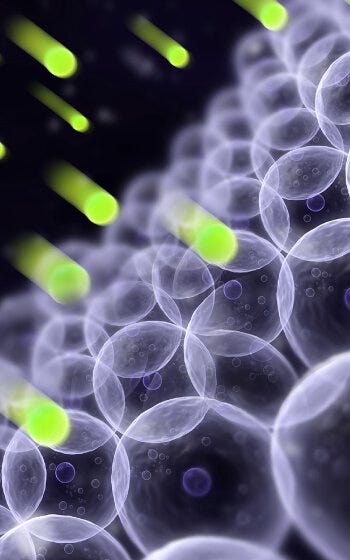
Free radicals are today considered enemy number one in harming the skin and body’s health. They are found in the air everywhere on earth and are also produced by the body as part of the aging process that begins from the day we are born. Free radicals are, for example, the reason why our sight and hearing weakens in old age, and of course, the main reason for visible aging of the facial skin.
How are they formed?
Several chemical atoms formed in various processes in the body produce a chain of molecules that are the basis of cells and the body’s activity. A free radical is a broken atom in the molecular chain with a negative charge (electron). By nature, a broken molecule aims to join and become balanced by adhering to positive charges found in whole molecules that compose fats, proteins, amino acids, collagen, and the rest of the chains that build the human body. The process of joining a complete molecular chain of living cells creates a new cycle of broken molecules with a negative charge.
Simulation of free radical damage can be performed by examining the cell envelope. Attaching a free radical to a whole molecule that is part of the envelope forms a kind of perforation. When the quantity of perforations increases, the cell envelope becomes a filter through which the free radicals may penetrate and also destroy the internal components of the cell, such as the DNA. The visual result of a damaged cell is a wrinkle in the skin – aging is in fact the result of an ongoing process of free radical damage.
Factors
The key factors in the formation of free radicals in the skin are:
- Normal chemical processes, such as energy or lipid production, form free radicals as a natural secondary process.
- Unprotected exposure to radiation.
- Air pollution.
- Applying substances to the skin that form free radicals.
The way to slow down the aging process is simple: removing one or more of the factors that form free radicals slows down the process. For example, constant protection from solar radiation will substantially reduce the formation and attack of radicals on the skin cells. Of course, neutralizing two to three factors increases the general anti-aging effect and will improve the skin condition.
Most of the bodily chemical processes produce free radicals, among them digestion, energy production, breathing, exercising the muscles, and producing melanin in the skin. In order to neutralize free radicals, we need antioxidants that provide them with the missing Positron and in this way stop the destructive process.
The huge advantage of antioxidants is in the fact that they can donate the positron without becoming free radicals. In this manner, they have become one of the most important factors in slowing down the aging process.
As part of the protection mechanism, the body produces its own antioxidants, such as superoxide dismutase, catalase, glutathione peroxidase, etc., but the quantities are insufficient to cope with the massive attack of radicals. The way of increasing the antioxidant level in the body is by supplying them from an external source – either by nutrition or application to the skin.
Antioxidants
Based on scientific evaluations, every cell (keratinocyte) in the epidermis is exposed to 5,000 free radicals daily. Therefore, facial skin, which is prone to continual exposure, ages more quickly than most other parts of the body. Reducing the antioxidant components in the skin layer accelerates aging with each passing day and year.
A diet rich in fruit and vegetables contains high concentrations of antioxidants, which are effective in anti-aging, but only 2%-3% of the antioxidants that we eat reach the skin.
A more effective method of protecting the skin is to supply it with antioxidants by external application and this is the origin of the popular term on the packaging of cosmetic products – “anti-aging”.
Local application of antioxidants on the skin provides it with the immediate ability to neutralize free radical formation. Direct application helps the epidermis in particular because beyond being directly exposed to radiation and pollution, this layer is not nourished by the blood system and therefore, it does not even receive the 2% that reaches the skin from nutrition.
In conclusion, meticulously applying skincare cream rich in vitamins and antioxidant daily is effective in preventing accelerated skin aging due to the action of free radicals.
